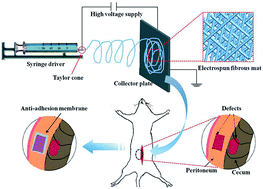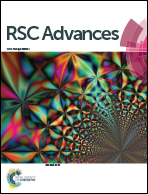Molecular weight-modulated electrospun poly(ε-caprolactone) membranes for postoperative adhesion prevention†
Abstract
Electrospun biodegradable polymer membranes can effectively serve as barriers to prevent postoperative intestinal adhesion. Previous studies have largely focused on utilizing different electrospun variables to regulate membrane properties, but paid very limited attention to the straightforward influences of raw material characteristics. In the present work, the physical and physiological properties of electrospun poly(ε-caprolactone) (PCL) membranes with varying viscosity-average molecular weights (Mη = 40 000, 80 000 and 120 000 g mol−1) were explored for the first time. Interestingly, the typical properties of electrospun films, such as the morphological structure, mechanical properties, degradation kinetics and the anti-adhesion effect, were revealed to be substantially dependent on the molecular weight. In clear contrast, the PCL sample with the viscosity-average molecular weight of 80 000 g mol−1 exhibited the best performance, including a regular fibrous morphology, superior tensile strength and Young's modulus of 1.13 and 8.41 MPa, respectively, which was presumably ascribed to the means of chain entanglements and interactions. Most importantly, no cytotoxicity was traced in the electrospun PCL membranes as revealed from the cell culture test; moreover, a significant reduction of postoperative adhesion was observed. Because of the above mentioned excellent merits, the electrospun PCL membranes can be regarded as excellent candidates for the anti-adhesion applications.


 Please wait while we load your content...
Please wait while we load your content...